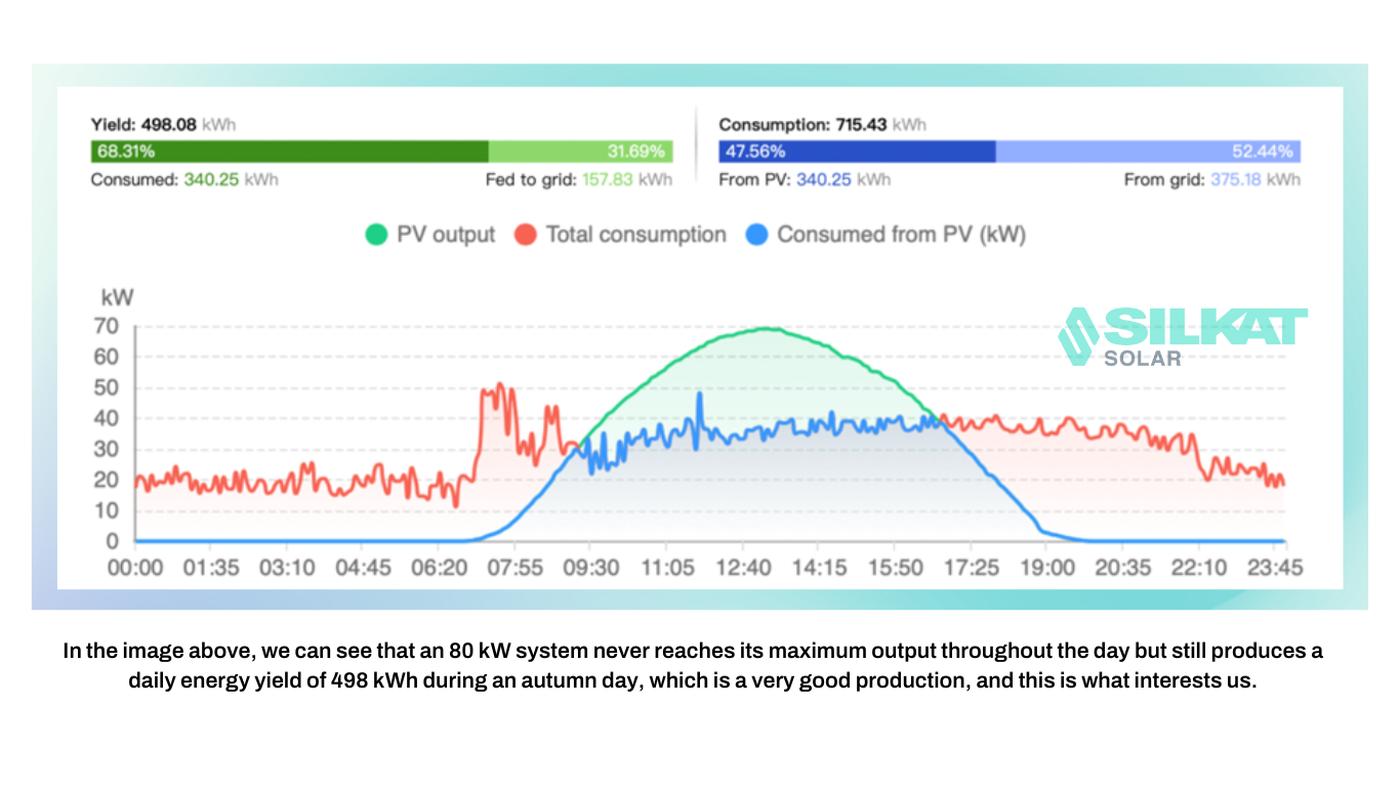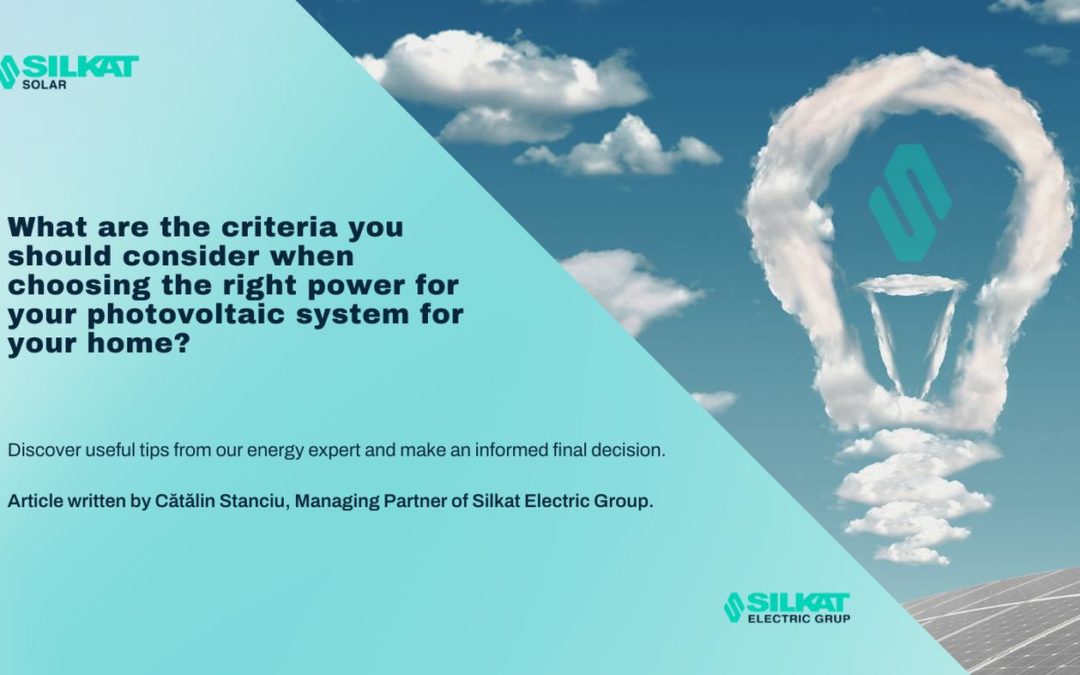Before installing a photovoltaic system, it is crucial to determine the appropriate system power for your space. We have often started this debate, and just as often, we have felt like, along with the system’s beneficiary, we are in the scenario of two tanks meeting, and after their commanders come out of the turret, one asks:
– “How many?”
– “Seven!” the other responds.
– “What seven?” the first one asks.
– “What seven?” the other responds.
Leaving jokes aside, this happens because in all presentations and offers for photovoltaic systems, installed power is more frequently highlighted, while the energy produced by the system is mentioned less often. Therefore, first, we will define these two concepts to move forward.
- THE POWER OF THE PHOTOVOLTAIC SYSTEM is measured in kW and represents the maximum energy that the system can theoretically deliver at any given moment under ideal conditions. For example, a 10 kW system will produce the maximum of 10 kW for short periods of time and, for the rest of the time, in real-world conditions, it will be somewhere in the range of 0-10 kW.
- PRODUCED ENERGY is measured in kWh and represents the energy generated by the system over a period of time. Practically, this is the energy that a photovoltaic system owner benefits from. This is the energy that electrical appliances consume.
If the POWER OF THE SYSTEM is the cow, the ENERGY PRODUCED is the milk!
As a consumer, I’m not interested in how big or small the cow is, but how much milk it produces.

There are situations where a system with an installed power of 20 kW, which is affected by shading from other buildings or is improperly designed, produces less energy than a properly designed 10 kW system placed in an optimal location. This quantity of energy produced, expressed in kWh, is similar to the energy consumption we all find on our monthly bills.

Energy consumption is the most important factor to consider when choosing the power of a photovoltaic system, along with other factors that can be found in the list below.
FACTORS TO CONSIDER FOR DETERMINING THE POWER AND SIZE OF A PHOTOVOLTAIC SYSTEM:
- CURRENT ENERGY CONSUMPTION: The first and most important factor in determining the power of the photovoltaic system to install is the energy consumption inside the location where the system will be installed. You need to evaluate how much electrical energy your home or space consumes on average per month or per year. This figure will help you determine how large your system should be to meet the energy needs of your home or space. A system can be designed to provide a portion or the entire energy consumption.
- PROJECTED ENERGY CONSUMPTION: Consider whether there will be significant electricity consumers in the space intended for the photovoltaic system in the future. The most significant consumers that can significantly affect consumption are electric heating systems (electric boilers or heat pumps), electric cars, heated swimming pools, and circulation pumps.
- GEOGRAPHICAL LOCATION: The geographical location plays a crucial role in the efficiency of a photovoltaic system. The amount of solar radiation received by the building or space where the photovoltaic system will be installed can vary considerably depending on the geographical area. To determine how much solar energy you can capture, you should consider the surrounding environment, roof orientation, and any potential shading that could affect system performance. Keep in mind that the duration of the period with heavy snowfall negatively impacts electricity production.
- AVAILABLE BUDGET AND PERSONAL OBJECTIVES: The cost of installing a photovoltaic system varies depending on its size and the selected equipment. It is important to establish a clear budget before making a decision. However, it’s important to note that a larger and more powerful system will have periods when it generates more energy than can be locally consumed, and this excess energy will be fed back into the national grid, with the recovery always being uncertain. Therefore, a smaller system whose energy is consumed locally to a greater extent will pay off more quickly over time. If return on investment matters, choosing a smaller system is the right option.
Calculating the Power of the Photovoltaic System:
To calculate the required power of the photovoltaic system, you can follow these steps:
- Determine monthly or annual energy consumption: Analyze the history of electricity bills to understand how much energy you consume on average per month or per year.
- Estimate solar energy production: Consult a specialized company in photovoltaic panel installation, such as Silkat Solar, which also has a design department and can provide you with a professional study to determine the estimated production you will obtain.
- Determine the system size: By working with the same company, you can determine from the design phase what the appropriate system size is to produce the desired energy, but you will also find out if your roof can support the desired system.
- Determine all system components to have the total cost: It is always recommended to consider a visit from a representative of the installer to the location where the photovoltaic system will be installed to identify on-site whether additional work or materials beyond those included in a standard offer are needed. Request to establish:
– Inverter location
– Panel location
– Cable routes to be installed
– Grounding execution
– Roof access method
– Type of metal structure used
– Consulting services for obtaining prosumer status
– Monitoring services, warranty, etc.
Only in this way will you have a final amount that cannot be altered later, and you will avoid exceeding your budget.
Conclusion:
Choosing the right power for your photovoltaic system is an essential step in transitioning to solar energy. It is important to consider your energy consumption, geographical location, available budget, and your goals to determine the correct system size. Always consult a solar energy specialist or a qualified installer for additional advice and assistance in making this important decision.

Only with a well-sized photovoltaic system will you be able to enjoy the benefits of solar energy and contribute to environmental protection.
Article written by Cătălin Stanciu, Managing Partner of Silkat Electric Group
For more details, you can reach out at catalin.stanciu@silkat.ro



